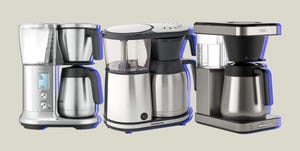If you consider yourself a coffee nerd or just a fan of good design, you’ve probably come across Fellow’s Stagg EKG Electric Kettle and Ode Brew Grinder. In recent years, both products have become indispensable not only for discerning at-home coffee enthusiasts but for caretakers of the most stylish Instagram accounts who have to keep their spaces looking as fashionable as possible. Given the two products’ popularity with seemingly every single demographic targeted by Fellow, you’d think the brand would be happy to just sit on their success for the foreseeable future.
But you’d be wrong. In October of 2022, Fellow introduced the Stagg EKG Pro and Pro Studio Edition (essentially the same, but built with fancier materials) as upgraded versions of their flagship electric gooseneck kettle. A month later, the company debuted the second generation of the Ode Brew Grinder. With both new devices promising an improved user experience over their predecessors, I wanted to see if Fellow’s new gear was truly worth the upgrade.
I’ve been testing both products for the better part of the last two months. Here’s what I’ve discovered.
What's Good About the Fellow Stagg EKG Pro
It's Mostly the Same
You've heard the expression "don't throw out the baby with the bath water?" Well, the same goes for kettles and, uh, kettle water. In other words: there was a whole lot to love about the original Fellow Stagg EKG kettle, and I'm glad that it's remained mostly unchanged for the Pro version.
That means you're getting the same basic design, with only a few minor tweaks to improve functionality (the vent on the lid is more efficient and the buttons on the base have changed). The kettle still heats up just as fast, still offers precision to-the-degree temperature control, still pours just as precisely and still looks just as sharp.
It Offers Improved Control and Customization
As for the changes Fellow did make, they do a pretty great job of improving what was already a really good user experience. While the previous version had a dial on the front of the base for setting the temperature and two switches on the back for switching between Fahrenheit and Celsius and turning on the hold function, the new base removes all switches from the back and now features a more streamlined setup with a small menu button next to the larger dial (which doubles as a power button). Also new is the display, which is now in full color. This feature may seem unnecessary, but I actually consider it to be quite useful, as the different colors help distinguish between the color-coded settings on the kettle when cycling through them with the dial.
And there are a lot of new features to keep track of. With the selector wheel and menu button as your guides, you can cycle through eight different categories. Some of these I use all the time, like setting my temperature or setting my hold time (though once you make a setting, the kettle will remember it until you change it again — you don't need to make these selections every time).
Others are more like curiosities. The Chime setting will make the kettle sound when your water reaches your desired temperature — my dog barks at the noise so I don't use it. An Altitude setting can set your altitude up to 9,900 feet above sea level — this is also unnecessary for me. The Schedule feature lets you schedule your brews in advance, which is nice in theory, but I'm never in such a hurry in the morning that I can't just spend the two minutes heating my water. There's also a Pre-Boil feature that sanitizes the kettle prior to settling on your chosen temp, a Units setting for toggling between F and C and a General category for setting things like your clock and WiFi (more on that later).
Finally, there's the new Guide setting, which gives you a selection of pre-set temperatures for making different kinds of beverages. This one's pretty handy when you don't feel like consulting Google for things like the proper temperature at which to brew white tea. I personally don't need all of the settings offered by the Stagg EKG Pro right now, but having the extra features is nice, as you never know when your situation might change.
What's Not Ideal About the Fellow Stagg EKG Pro
The App Isn't Very Useful
So, that WiFi connectivity I mentioned. You'd think it would be for smart home connectivity — "Alexa, turn on my Fellow kettle!" — but alas, that's not the case. Instead, the WiFi is so your kettle can communicate with the Fellow app. Surely, the app must offer some control over the kettle? Again ... no. All the app does is tell you if your firmware is up to date, and if it isn't, offer you an over-the-air download.
In my experience, it's been extremely buggy — it took weeks and multiple app re-installs to download my first update. The app in general just seems unnecessary at this point, and frankly so does the kettle's WiFi connectivity. I can only hope that Fellow has big plans for both in the future, because right now they feel like a wasted opportunity.
There Are No Internal Measurements
This is a minor gripe, but would it kill Fellow to put some markings on the inside of the kettle to show how much water you've added? There's just one line — a "Max" line — and that's it. The kettle does have a minimum requirement of a not-terribly-small 11 ounces, so even a "Min" line would be helpful. Instead, I'm forced to use a measuring cup every time I need to fill my kettle, which feels like an unnecessary step that could easily be amended by some markings on the kettle's interior.
What's Good About the Fellow Ode Brew Grinder Gen 2
Again — It’s Mostly the Same
Like the updated kettle, Fellow's Ode Brew Grinder Gen 2 largely sticks to the script written by its forebearer. It looks almost identical (it's a hair taller) and has many of the same features that got the original so many fans in the first place. The giant grind selector dial still has 31 options, the hopper is still pleasantly sleek and compact, the grinder is still ultra-quiet and the catch still satisfyingly clicks into place via magnets. It's as much of a pleasure to use as ever.
And the changes Fellow did make are arguably even more sensical than the improvements the brand made to the kettle. The hopper has been redesigned, so the beans now feed more efficiently (I've never had even a single bean fail to load), and the redesigned burrs are able to grind finer than ever before (though still not fine enough for espresso).
It's Easier to Clean
Perhaps the biggest complaint about the original Ode grinder was how messy it was. The thing was a looker, no doubt, but it seemed to constantly be covered in coffee grounds. To address this problem, Fellow has introduced anti-static technology into the Ode 2, and it works like a charm. This is the cleanest coffee grinder I've ever used, and the anti-static tech is no joke — there really is none of that usual phenomenon of grounds clinging to everything from static and making a huge mess.
What's Not Ideal About the Fellow Ode Brew Grinder Gen 2
The Power Button Is in an Awkward Spot
Like on the original, the power button on the updated Ode Brew is on the front of the grinder at the very bottom. It's not necessarily difficult to press (though it could be easier) — the issue is when moving the grinder. I can't tell you how many times I've tried to nudge my grinder over a bit only to inadvertently press the button and start the grinder, which usually results in a small errant pile of leftover grounds that I then have to clean up. This may be a nitpick, but it's something that's definitely gotten on my nerves while using this grinder.
The Catch Isn't the Most Efficient Pourer
While the catch may not get as messy as before, it still isn't the best when it comes to pouring out your freshly-ground coffee. That's because its spout design incorporates two cliffs that effectively block some of your coffee from exiting, meaning you have to turn it right-side up a handful of times while pouring before you can fully empty the catch. Also, while it's true that this updated grinder is considerably cleaner than before, it isn't spotless. Stray grounds will still find their way outside the catch, and the channeled design of the grinder creates a great hiding place for them, making them somewhat difficult to remove.
Alternatives
For an alternative to the Stagg EKG Pro, you've got options. The device has become such an icon that other brands have taken notice, and you can get capable dupes from the likes of Cuisinart, which offers similar looks and functionality to the non-Pro Stagg EKG, Cosori, which again apes the look but lacks precision temperature control, and Balmuda, which has standout designer looks but is the most simple when it comes to functionality. They're all cheaper than the Fellow, but don't offer the same feature set.
When it comes to the grinder, you're a bit more limited. Zwilling makes a conical burr grinder with a somewhat similar look and a whopping 140 adjustment options. But it has a lot more plastic in its build and is much louder. For performance without the looks, you can always look to Baratza. Their grinders may not be as stylish, but they're tough to beat when it comes to performance.
The Verdict
Fellow's Stagg EKG Kettle and Ode Brew Grinder used to be the best products in their respective categories, but now they're not — because they've been replaced by the Stagg EKG Pro and Ode Brew 2. Fellow's updated kettle and grinder are unquestionably better than the originals, but are they worth the upgrade?
If you've already got the originals, I wouldn't bother making the step up. While the new devices offer better performance, it's not $540 worth better, which is what the two devices cost together ($195 for the kettle, $345 for the grinder). And if you don't have either and are in the market for one? In that case, I'd say go for the new ones.
The Pro is just $30 more than the regular Stagg EKG, and it offers a lot more functionality — even if you don't think you'll make use of all of it, it's worth three Hamiltons. As for the grinder, that's a tougher pill to swallow ... $345 versus the marked-down price of $255 for the original. At a nearly-$100 difference, it becomes a much harder decision. I'd still say the upgrade is worth it thanks to how much cleaner the Gen 2 grinder is, but you'll have to decide for yourself how much that cleanliness is worth.
























